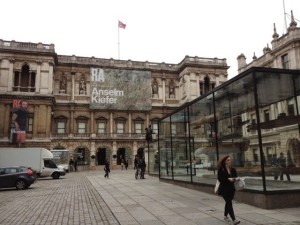Anselm Kiefer – Royal Academy, London

Coming at Kiefer ‘fresh’, therefore, I found, like many before me, an artist whose works centre on an engagement with twentieth century history, with a strong repertoire of recurrent imagery and a love of using unusual media in his works. I thought the exhibition itself was well designed in its progression from his inspiration, process and early work, to interior then exterior spaces, and then an exploration of various motifs and ideas. The large scale and sometimes operatic nature of Kiefer’s paintings and sculptures makes him an almost ideal candidate for a solo show in the imposing rooms of the Royal Academy, and the notes I made for myself included the impression that it was “not astounding, but a very solid show”.
What, then, worked well for me? For a start, there were several works on display which I enjoyed, either for their aesthetics, power, or innovative use of materials. ‘Sulamith’ (1983) for example, portrays an immense and ominous architectural space, in a silent yet powerful testament to the horror of the Holocaust. ‘Operation Sea Lion’ (1975) took my fancy in its resemblance to a multiple exposure photograph, while one has to admire the imagination that leads an artist to create a work such as ‘Die Treppe’ (1982-3) from emulsion, shellac, straw and scorch marks on photographs on document paper on canvas. And that’s even before you get to the sand, clay, lead and diamonds. I also enjoyed the variety in the sameness throughout the exhibition: while Kiefer’s work can tend to seem monochromatic after a while, with motifs recurring throughout, there are points where you are surprised by colour, or by delicate watercolours, or by the pleasure of walking through a forest painted on interlocking screens. I think again this comes down to good curation, and also the fact that Kiefer created new and site-specific works which balanced out the older works on display.
There was not anything particularly which did not work for me. As I mentioned, there is a risk of repetitiveness in seeing 12 rooms of works by an artist with an often limited colour palette, but personally I didn’t mind this too much. I felt there were a large number of historical and artistic references needed to keep up with the show, from Romanticism to Mesopotamia to alchemy to poetry, but being demanding of an audience is not necessarily a negative thing. Having read a few reviews now, I think I would have been more wary coming in had I been forearmed with the popular view of Kiefer. He is generally respected by critics, but often with a sense of solemnity at his heavy themes and weary sighing insistent theatricality. ‘Not astounding, but a very solid show’ does sum it up for me in the end: I will not be rushing to every Kiefer show I see, but I am glad to know a lot more about the artist and his work.
